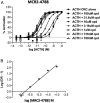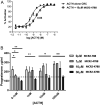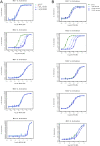Identification of a novel specific small-molecule melanocortin-2-receptor antagonist
- PMID: 36515667
- PMCID: PMC9641778
- DOI: 10.1530/EC-22-0338
Identification of a novel specific small-molecule melanocortin-2-receptor antagonist
Abstract
The overproduction of adrenocorticotropic hormone (ACTH), in conditions such as Cushing's disease and congenital adrenal hyperplasia (CAH), leads to significant morbidity. Current treatment with glucocorticoids does not adequately suppress plasma ACTH, resulting in excess adrenal androgen production. At present, there is no effective medical treatment in clinical use that would directly block the action of ACTH. Such a therapy would be of great clinical value. ACTH acts via a highly selective receptor, the melanocortin-2 receptor (MC2R) associated with its accessory protein MRAP. ACTH is the only known naturally occurring agonist for this receptor. This lack of redundancy and the high degree of ligand specificity suggest that antagonism of this receptor could provide a useful therapeutic strategy in the treatment of conditions of ACTH excess. To this end, we screened an extensive library of low-molecular-weight drug-like compounds for MC2R antagonist activity using a high-throughput homogeneous time-resolved fluorescence cAMP assay in Chinese hamster ovary cells stably co-expressing human MC2R and MRAP. Hits that demonstrated MC2R antagonist properties were counter-screened against the β2 adrenergic receptor and dose-response analysis undertaken. This led to the identification of a highly specific MC2R antagonist capable of antagonising ACTH-induced progesterone release in murine Y-1 adrenal cells and having selectivity for MC2R amongst the human melanocortin receptors. This work provides a foundation for the clinical investigation of small-molecule ACTH antagonists as therapeutic agents and proof of concept for the screening and discovery of such compounds.
Keywords: GPCR antagonism; MC2R; MRAP; adrenal; drug discovery.
Figures





References
-
- Noon LA, Franklin JM, King PJ, Goulding NJ, Hunyady L, Clark AJ. Failed export of the adrenocorticotrophin receptor from the endoplasmic reticulum in non-adrenal cells: evidence in support of a requirement for a specific adrenal accessory factor. Journal of Endocrinology 200217417–25. (10.1677/joe.0.1740017) - DOI - PubMed
-
- Metherell LA, Chapple JP, Cooray S, David A, Becker C, Ruschendorf F, Naville D, Begeot M, Khoo B, Nurnberg Pet al.Mutations in MRAP, encoding a new interacting partner of the ACTH receptor, cause familial glucocorticoid deficiency type 2. Nature Genetics 200537166–170. (10.1038/ng1501) - DOI - PubMed
Grants and funding
LinkOut - more resources
Full Text Sources
Other Literature Sources
Research Materials

